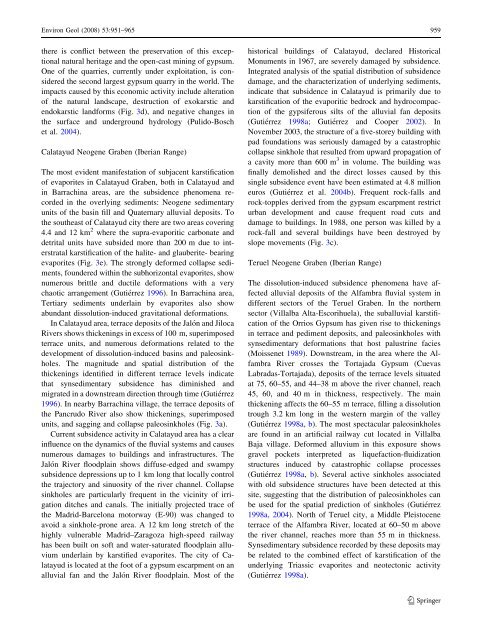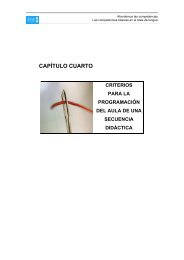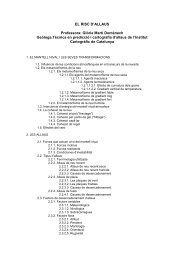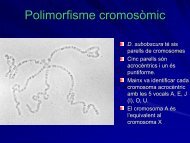Geological and environmental implications of the evaporite karst in Spain
Geological and environmental implications of the evaporite karst in Spain
Geological and environmental implications of the evaporite karst in Spain
You also want an ePaper? Increase the reach of your titles
YUMPU automatically turns print PDFs into web optimized ePapers that Google loves.
Environ Geol (2008) 53:951–965 959<br />
<strong>the</strong>re is conflict between <strong>the</strong> preservation <strong>of</strong> this exceptional<br />
natural heritage <strong>and</strong> <strong>the</strong> open-cast m<strong>in</strong><strong>in</strong>g <strong>of</strong> gypsum.<br />
One <strong>of</strong> <strong>the</strong> quarries, currently under exploitation, is considered<br />
<strong>the</strong> second largest gypsum quarry <strong>in</strong> <strong>the</strong> world. The<br />
impacts caused by this economic activity <strong>in</strong>clude alteration<br />
<strong>of</strong> <strong>the</strong> natural l<strong>and</strong>scape, destruction <strong>of</strong> exo<strong>karst</strong>ic <strong>and</strong><br />
endo<strong>karst</strong>ic l<strong>and</strong>forms (Fig. 3d), <strong>and</strong> negative changes <strong>in</strong><br />
<strong>the</strong> surface <strong>and</strong> underground hydrology (Pulido-Bosch<br />
et al. 2004).<br />
Calatayud Neogene Graben (Iberian Range)<br />
The most evident manifestation <strong>of</strong> subjacent <strong>karst</strong>ification<br />
<strong>of</strong> <strong>evaporite</strong>s <strong>in</strong> Calatayud Graben, both <strong>in</strong> Calatayud <strong>and</strong><br />
<strong>in</strong> Barrach<strong>in</strong>a areas, are <strong>the</strong> subsidence phenomena recorded<br />
<strong>in</strong> <strong>the</strong> overly<strong>in</strong>g sediments: Neogene sedimentary<br />
units <strong>of</strong> <strong>the</strong> bas<strong>in</strong> fill <strong>and</strong> Quaternary alluvial deposits. To<br />
<strong>the</strong> sou<strong>the</strong>ast <strong>of</strong> Calatayud city <strong>the</strong>re are two areas cover<strong>in</strong>g<br />
4.4 <strong>and</strong> 12 km 2 where <strong>the</strong> supra-evaporitic carbonate <strong>and</strong><br />
detrital units have subsided more than 200 m due to <strong>in</strong>terstratal<br />
<strong>karst</strong>ification <strong>of</strong> <strong>the</strong> halite- <strong>and</strong> glauberite- bear<strong>in</strong>g<br />
<strong>evaporite</strong>s (Fig. 3e). The strongly deformed collapse sediments,<br />
foundered with<strong>in</strong> <strong>the</strong> subhorizontal <strong>evaporite</strong>s, show<br />
numerous brittle <strong>and</strong> ductile deformations with a very<br />
chaotic arrangement (Gutiérrez 1996). In Barrach<strong>in</strong>a area,<br />
Tertiary sediments underla<strong>in</strong> by <strong>evaporite</strong>s also show<br />
abundant dissolution-<strong>in</strong>duced gravitational deformations.<br />
In Calatayud area, terrace deposits <strong>of</strong> <strong>the</strong> Jalón <strong>and</strong> Jiloca<br />
Rivers shows thicken<strong>in</strong>gs <strong>in</strong> excess <strong>of</strong> 100 m, superimposed<br />
terrace units, <strong>and</strong> numerous deformations related to <strong>the</strong><br />
development <strong>of</strong> dissolution-<strong>in</strong>duced bas<strong>in</strong>s <strong>and</strong> paleos<strong>in</strong>kholes.<br />
The magnitude <strong>and</strong> spatial distribution <strong>of</strong> <strong>the</strong><br />
thicken<strong>in</strong>gs identified <strong>in</strong> different terrace levels <strong>in</strong>dicate<br />
that synsedimentary subsidence has dim<strong>in</strong>ished <strong>and</strong><br />
migrated <strong>in</strong> a downstream direction through time (Gutiérrez<br />
1996). In nearby Barrach<strong>in</strong>a village, <strong>the</strong> terrace deposits <strong>of</strong><br />
<strong>the</strong> Pancrudo River also show thicken<strong>in</strong>gs, superimposed<br />
units, <strong>and</strong> sagg<strong>in</strong>g <strong>and</strong> collapse paleos<strong>in</strong>kholes (Fig. 3a).<br />
Current subsidence activity <strong>in</strong> Calatayud area has a clear<br />
<strong>in</strong>fluence on <strong>the</strong> dynamics <strong>of</strong> <strong>the</strong> fluvial systems <strong>and</strong> causes<br />
numerous damages to build<strong>in</strong>gs <strong>and</strong> <strong>in</strong>frastructures. The<br />
Jalón River floodpla<strong>in</strong> shows diffuse-edged <strong>and</strong> swampy<br />
subsidence depressions up to 1 km long that locally control<br />
<strong>the</strong> trajectory <strong>and</strong> s<strong>in</strong>uosity <strong>of</strong> <strong>the</strong> river channel. Collapse<br />
s<strong>in</strong>kholes are particularly frequent <strong>in</strong> <strong>the</strong> vic<strong>in</strong>ity <strong>of</strong> irrigation<br />
ditches <strong>and</strong> canals. The <strong>in</strong>itially projected trace <strong>of</strong><br />
<strong>the</strong> Madrid-Barcelona motorway (E-90) was changed to<br />
avoid a s<strong>in</strong>khole-prone area. A 12 km long stretch <strong>of</strong> <strong>the</strong><br />
highly vulnerable Madrid–Zaragoza high-speed railway<br />
has been built on s<strong>of</strong>t <strong>and</strong> water-saturated floodpla<strong>in</strong> alluvium<br />
underla<strong>in</strong> by <strong>karst</strong>ified <strong>evaporite</strong>s. The city <strong>of</strong> Calatayud<br />
is located at <strong>the</strong> foot <strong>of</strong> a gypsum escarpment on an<br />
alluvial fan <strong>and</strong> <strong>the</strong> Jalón River floodpla<strong>in</strong>. Most <strong>of</strong> <strong>the</strong><br />
historical build<strong>in</strong>gs <strong>of</strong> Calatayud, declared Historical<br />
Monuments <strong>in</strong> 1967, are severely damaged by subsidence.<br />
Integrated analysis <strong>of</strong> <strong>the</strong> spatial distribution <strong>of</strong> subsidence<br />
damage, <strong>and</strong> <strong>the</strong> characterization <strong>of</strong> underly<strong>in</strong>g sediments,<br />
<strong>in</strong>dicate that subsidence <strong>in</strong> Calatayud is primarily due to<br />
<strong>karst</strong>ification <strong>of</strong> <strong>the</strong> evaporitic bedrock <strong>and</strong> hydrocompaction<br />
<strong>of</strong> <strong>the</strong> gypsiferous silts <strong>of</strong> <strong>the</strong> alluvial fan deposits<br />
(Gutiérrez 1998a; Gutiérrez <strong>and</strong> Cooper 2002). In<br />
November 2003, <strong>the</strong> structure <strong>of</strong> a five-storey build<strong>in</strong>g with<br />
pad foundations was seriously damaged by a catastrophic<br />
collapse s<strong>in</strong>khole that resulted from upward propagation <strong>of</strong><br />
a cavity more than 600 m 3 <strong>in</strong> volume. The build<strong>in</strong>g was<br />
f<strong>in</strong>ally demolished <strong>and</strong> <strong>the</strong> direct losses caused by this<br />
s<strong>in</strong>gle subsidence event have been estimated at 4.8 million<br />
euros (Gutiérrez et al. 2004b). Frequent rock-falls <strong>and</strong><br />
rock-topples derived from <strong>the</strong> gypsum escarpment restrict<br />
urban development <strong>and</strong> cause frequent road cuts <strong>and</strong><br />
damage to build<strong>in</strong>gs. In 1988, one person was killed by a<br />
rock-fall <strong>and</strong> several build<strong>in</strong>gs have been destroyed by<br />
slope movements (Fig. 3c).<br />
Teruel Neogene Graben (Iberian Range)<br />
The dissolution-<strong>in</strong>duced subsidence phenomena have affected<br />
alluvial deposits <strong>of</strong> <strong>the</strong> Alfambra fluvial system <strong>in</strong><br />
different sectors <strong>of</strong> <strong>the</strong> Teruel Graben. In <strong>the</strong> nor<strong>the</strong>rn<br />
sector (Villalba Alta-Escorihuela), <strong>the</strong> suballuvial <strong>karst</strong>ification<br />
<strong>of</strong> <strong>the</strong> Orrios Gypsum has given rise to thicken<strong>in</strong>gs<br />
<strong>in</strong> terrace <strong>and</strong> pediment deposits, <strong>and</strong> paleos<strong>in</strong>kholes with<br />
synsedimentary deformations that host palustr<strong>in</strong>e facies<br />
(Moissenet 1989). Downstream, <strong>in</strong> <strong>the</strong> area where <strong>the</strong> Alfambra<br />
River crosses <strong>the</strong> Tortajada Gypsum (Cuevas<br />
Labradas-Tortajada), deposits <strong>of</strong> <strong>the</strong> terrace levels situated<br />
at 75, 60–55, <strong>and</strong> 44–38 m above <strong>the</strong> river channel, reach<br />
45, 60, <strong>and</strong> 40 m <strong>in</strong> thickness, respectively. The ma<strong>in</strong><br />
thicken<strong>in</strong>g affects <strong>the</strong> 60–55 m terrace, fill<strong>in</strong>g a dissolution<br />
trough 3.2 km long <strong>in</strong> <strong>the</strong> western marg<strong>in</strong> <strong>of</strong> <strong>the</strong> valley<br />
(Gutiérrez 1998a, b). The most spectacular paleos<strong>in</strong>kholes<br />
are found <strong>in</strong> an artificial railway cut located <strong>in</strong> Villalba<br />
Baja village. Deformed alluvium <strong>in</strong> this exposure shows<br />
gravel pockets <strong>in</strong>terpreted as liquefaction-fluidization<br />
structures <strong>in</strong>duced by catastrophic collapse processes<br />
(Gutiérrez 1998a, b). Several active s<strong>in</strong>kholes associated<br />
with old subsidence structures have been detected at this<br />
site, suggest<strong>in</strong>g that <strong>the</strong> distribution <strong>of</strong> paleos<strong>in</strong>kholes can<br />
be used for <strong>the</strong> spatial prediction <strong>of</strong> s<strong>in</strong>kholes (Gutiérrez<br />
1998a, 2004). North <strong>of</strong> Teruel city, a Middle Pleistocene<br />
terrace <strong>of</strong> <strong>the</strong> Alfambra River, located at 60–50 m above<br />
<strong>the</strong> river channel, reaches more than 55 m <strong>in</strong> thickness.<br />
Synsedimentary subsidence recorded by <strong>the</strong>se deposits may<br />
be related to <strong>the</strong> comb<strong>in</strong>ed effect <strong>of</strong> <strong>karst</strong>ification <strong>of</strong> <strong>the</strong><br />
underly<strong>in</strong>g Triassic <strong>evaporite</strong>s <strong>and</strong> neotectonic activity<br />
(Gutiérrez 1998a).<br />
123





